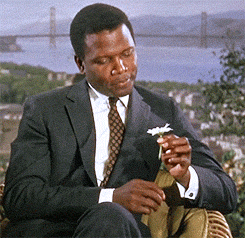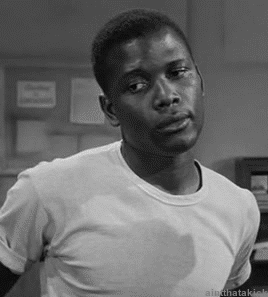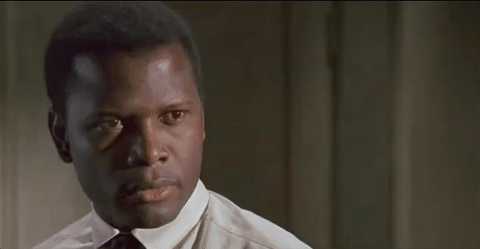The love, the hate, everything great about Sidney Poitier
expose on Sidney Poitier, see what I did there
If you don’t know who Sidney Poitier is because you’ve been living under a rock or just Black history isn’t important to you, allow me to be your introduction to one of, if not the greatest Black artist/actor in time. Sidney started late in the game, unlike how it is now, where Black or any artist has to either been born or studied the craft for a long time, he did not. Sidney was a dishwasher in the 1940s when he auditioned for a role at the American Negro Theater. He wasn’t able to finish his audition, being ushered out, because of his inexperience. He took it with grace and bounced back, learning to refine his acting skills, he kept coming back for more auditions. Over time to help build his skills, he started working as a janitor in between the classes the theater offered and even befriended a fellow student, Harry Belafonte, yes that Belafonte. Harry was one of the best in the theater, getting all of the roles that Sidney auditioned for. But one day, while Harry was out Sidney stood in for him. This helped him to land more roles in theater which also paved the way for him to break out in Hollywood. "[Black people] were so new in Hollywood. There was almost no frame of reference for us except as stereotypical, one-dimensional characters. I had in mind what was expected of me, not just what other Blacks expected but what my mother and father expected. And what I expected of myself," Poitier told Oprah Winfrey in a later interview. Sidney only took roles that portrayed or pushed the Black narrative in a positive way.
During Sidney’s rise in Hollywood so was the racial tension in America, during the Civil Rights Movement, Black people began to push back on Sidney’s portrayal of Black men. In the article “Why Does White America Love Sidney Poitier So?” by Clifford Mason written right after Sidney’s ‘In The Heat Of The Night' came out he goes on about Black people’s discontent with Sidney’s performances. Bringing up Sidney’s whole timeline, comparing his films to the two films ‘Porgy and Bess’ and ‘The Long Ships’ the two films that Sidney has expressed in an interview, trouble with those portrayals. In the article, Mason goes on a very angry rant(rightfully so) about how the White men view Black men or how Black men fit into the White man’s world. He brings up a lot of good points, arguably the best points made on Sidney’s whole career. One that I’d like to point out is the big matter of being the only representation for your people. Sidney was always the only leading Black man in these films with White costars which led the representation to lie on Sidney’s shoulder. Which in these films written, directed, and produced by White men wasn’t a lot. Mason says a lot but I’m just going to end it off with his last comment “But he remains unreal, as he has for nearly two decades, playing essentially the same role, the antiseptic, one-dimensional hero. If he keeps it up, he'll soon be able to give Sean Connery lessons in how to do the same role year after year after year. I can just see the two of them now: Connery, toothless and doddering, but still killing Asians, Turks and some white Communists, while 50 girls try to get his courage up. And Poitier, finally going to flesh, but still pure, still nonplussed by white arrogance and wanting onto to be left alone but, because of his innate goodness, finally making that fateful decision to solve the problem for ''them,'' good nigger that he is.”
Sidney goes on to direct his work stating, “When you make a picture for a Black audience, you have to make it with more loving care than you make your average picture. You have to be much more concerned with content and the sensibilities and sensitivities of your constituency. You must be tuned into their aspirations, hopes, and dreams.” When Sidney was finally able to create his own stories, he did so with an abundance of Black actors. His stories were the typical “Black” stories or just included Black people in them. He was always to let Black people have more sensibilities but also speak their truth. During this time, the Black society(majority) was living a certain lifestyle, what Sidney showed in his films allowed for both the realities of certain Black lifestyles to be seen but in a more respectful way.
If you want to read more articles about Sidney I’ve included 2 articles that talk about him, his work, and his achievements to the Black culture and society. I’ve also included Mason’s article, it is archived so bear with it.
https://blackfilmarchive.com/Sidney-Poitier-1
https://archive.nytimes.com/www.nytimes.com/packages/html/movies/bestpictures/heat-ar.html?scp=8&sq=Fact&st=cse
https://www.vulture.com/2022/01/my-sidney-poitier.html
I knew who Sidney Poitier was before film school, my parents were that “couple” in ‘Guess Who’s Coming To Dinner’. But I wasn’t as close to his work or him as an artist until junior year, and that’s when I started to explore the Black arts and film, after taking the rudimentary and foundation classes I was finally able to explore my interests. Taking blaxploitation classes, Black arts, and cultural impacts in film, I was able to delve into his work and him as a person more. The more I delved, the more I fell in love with him. His work touched me on not just a cultural and spiritual level but also as a Black artist.


I’ve talked about what it means to be a Black artist but I can’t remember if I approached the subject on here. Art will always be political/social/making a statement, even when the artist doesn’t want it to, no matter what, they are always stuck in this bubble. Artists who happen to be POC can make both art and POC art. Confusing right, well let me explain through film, it’s a little easier. A Black filmmaker can make a film but they can also make a Black film, we see this through different themes explored in Black culture vs. some of the characters/actors being Black. This is a big subject being brought up in blaxploitation or Black arts, we see White artists/filmmakers “make” Black film/art through the use of redevelopment(gentrification) of Black culture. That’s why the question of is it a Black film vs. is it a film with just Black people in it? Always arises.
Sidney toes the line of this conversation being in both White films and Black films, creating his own films as well. He and his work always developed Black stories or stories that include Black people. So to bring it back to the article, yes! Sidney was a Black man in a White man’s world but he has also been a Black man in a Black man’s world. Not to say I wasn’t a little disappointed with how he viewed his work which connects more with Black culture. But he’s right Black actors need to be included in “regular” society stories because once they view our work as just Black it becomes boxed in. This brings up a whole other discussion on Black joy vs. trauma porn(slavery movies). If we aren’t allowed to even get roles in societal stories then we won’t get a voice, inclusion, a seat, and so much more. They need to see us as a part of the story, not to say we don’t have our own stories and world that excludes them. Think of it like this, Black people are everywhere but are White people really integrated in the hood(ignore Eninmen, this is Detroit, we’re different)
film examples…
Guess Who’s Coming To Dinner(1967)
In The Heat Of The Night(1967)
Porgy and Bess(1959)
To Sir, with Love(1967)
The Defiant Ones(1958)
Uptown Saturday Night(1974)
In conclusion, Sidney Poitier is one of the greatest artists of all time, he had to be, the Black image was rested on his shoulder, that’s a heavy burden to carry, and I’m glad he did. Not to take away from the other great Black actors at the time, it was hard for everyone but to solely exist in White society as “the” Black man, that’s no easy feat. Black people tend to give our people a much harsher judgment than others and back then Sidney was a known source of this. We should as people understand that our people are already being judged by the rest of society and why should we play apart in that. Respectability politics aside unless the figure was outwardly a bad role model; homophobic, sexist, colorist, hateful towards other religions/races, and things like that, then there is no reason for us to judge so harshly. Personally, he made me think about my art and how I engage with it, which is a responsibility that I as a Black artist should be doing for the future of my people and society in general. Let’s give Sidney his flowers he deserves it after all.






